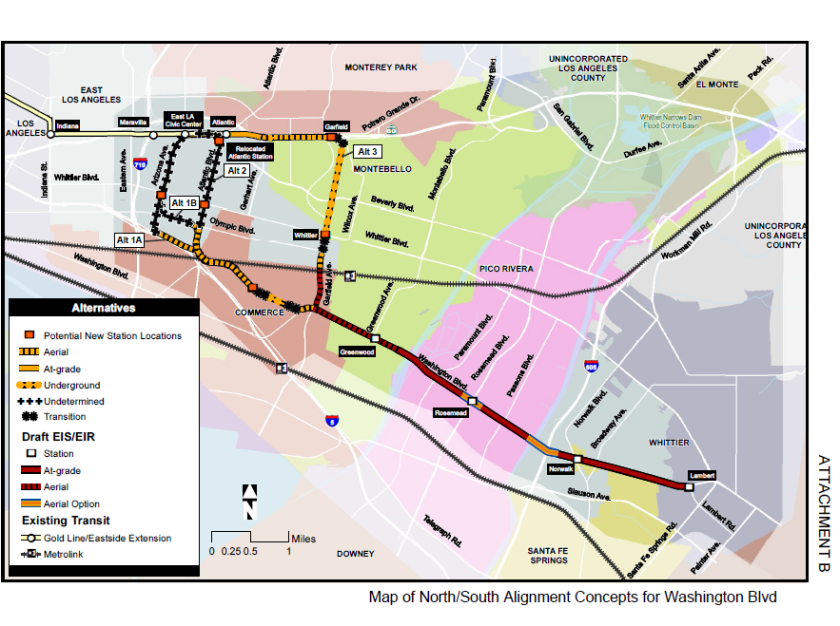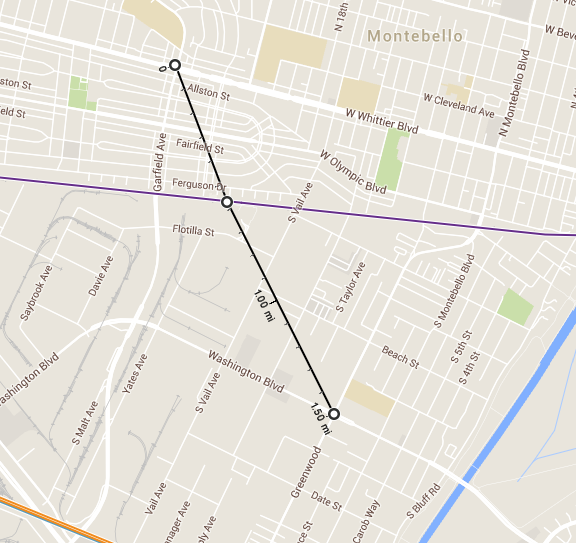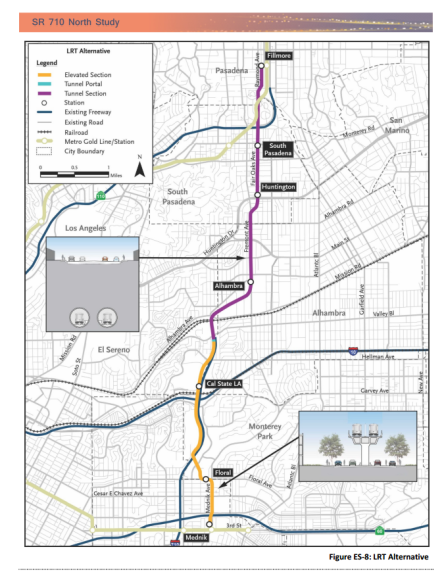 On Wednesday, Metro’s Planning and Programming Committee will receive refined options for the proposed Washington Blvd. alignment of the Eastside Gold Line extension. Original plans in the Draft Environmental Impact Report called for the light rail line to follow an aerial tracking along Garfield between Washington and the 60, but the route met with community opposition in Montebello, where dozens of businesses and 9 homes could have been taken out by construction. After initially labeling the community impact “adverse but not significant,” Metro agreed to seek out a more palatable connection to Washington as part of a larger technical study which, when completed later this year, will also report on the feasibility of building both LRT build alternatives from the DEIR: to South El Monte via the 60 ROW and to Whittier via Washington Boulevard. (Edit: The timeframe for delivery on the full technical study has been extended to the second quarter of 2017 to allow for increased time to discuss with stakeholders).
On Wednesday, Metro’s Planning and Programming Committee will receive refined options for the proposed Washington Blvd. alignment of the Eastside Gold Line extension. Original plans in the Draft Environmental Impact Report called for the light rail line to follow an aerial tracking along Garfield between Washington and the 60, but the route met with community opposition in Montebello, where dozens of businesses and 9 homes could have been taken out by construction. After initially labeling the community impact “adverse but not significant,” Metro agreed to seek out a more palatable connection to Washington as part of a larger technical study which, when completed later this year, will also report on the feasibility of building both LRT build alternatives from the DEIR: to South El Monte via the 60 ROW and to Whittier via Washington Boulevard. (Edit: The timeframe for delivery on the full technical study has been extended to the second quarter of 2017 to allow for increased time to discuss with stakeholders).
Of the four new proposed routes, the most eye-catching is Alternative 3, which would replace the above-grade section of the route through Montebello with an underground tunnel spanning approximately 1.3 miles to Whittier Boulevard where there would be a new station. From there, it would rejoin the original DEIR path just beyond the Montebello city limits in an aerial alignment down to Washington. The straight shot below-grade option would likely represent a time savings compared to the DEIR path, which skirted the edge of the Montebello Municipal Golf Course along a particularly circuitous portion of Garfield. A major and still unknown consideration would be the additional cost of such a tunnel and the accompanying station, but the impact could be significant for a project already expected to cost up to $3.2888 billion dollars in Year-of-Expenditure dollars. One obvious flaw is the total lack of connectivity between the Montebello/Commerce Metrolink station and the new LRT line, which otherwise could help boost the former’s sagging ridership. Metro should make efforts to consider extending this below grade option between the Whittier/Garfield and Washington/Greenwood stations, with an intermediary below-grade stop underneath the Metrolink Montebello station. This extra 1.5 miles of tunnel would replace another slow section of curvy track with a straightened alignment, and provide vast improvements in terms of regional connectivity. But regardless, this alternative seems to be the one to beat.

The remaining three alternatives haven’t been fleshed out much, but in their half-finished state there are some glaring issues that would be difficult to overcome. The Atlantic Blvd. alignment would require the existing at-grade Atlantic station to be moved from Pomona Blvd. to Beverly, either significantly complicating or eliminating completely the potential to run LRT along both the 60 and Washington routes. Because the South El Monte route runs primarily through the San Gabriel Valley COG and the Whittier line runs through the Gateway Cities COG, any alternative that doesn’t permit the construction of both is probably dead on arrival. There can be no doubt that Metro, deep in the middle of its campaign to sell a follow-up sales tax to build upon Measure R, does not want to be put in the position of picking between the two options. In order to meet an onerous 66.7% voter approval threshold to raise tax dollars, local transit officials would do nearly anything to avoid discord between the various regions of the county. But we’ll get back to that later.
The Arizona Ave. alignments prominently feature an impossible route geometry, whose hairpin turn from 3rd to Mednik would be dubious even if the East LA Civic Center station were not 300 feet east of Mednik. Indeed, alternatives 1A and 1B would seem more plausible from a geometry standpoint as a southeasterly extension of the designed-to-fail 710 North LRT option than as a branch of the Gold Line.

To have any credibility as a Gold Line option, Alternatives 1A and B would likely have to ditch Arizona altogether, maybe in favor of a .9 mile below-grade section from 3rd to Alt. 2’s Whittier/Atlantic station.
To be frank, none of the alternatives considered are likely to make transit advocates forget about the Whittier Boulevard Red Line extension that might have been, but it is good at least to see Metro considering mitigation measures that might increase ridership rather than hampering it. The Eastside Gold Line suffers from poor stop spacing(Maravilla, East LA Civic Center and Atlantic are all within one .75 mile stretch) and questionable neighborhood connectivity, both of which have hopefully yielded important lessons for phase 2 moving forward.
In the near future, we’ll be discussing the potential for branch service in southeast LA county to help regional mobility and possible light rail connectors between the Gold Line and the West Santa Ana Branch, as we await the full release of the technical study.
You must be logged in to post a comment.